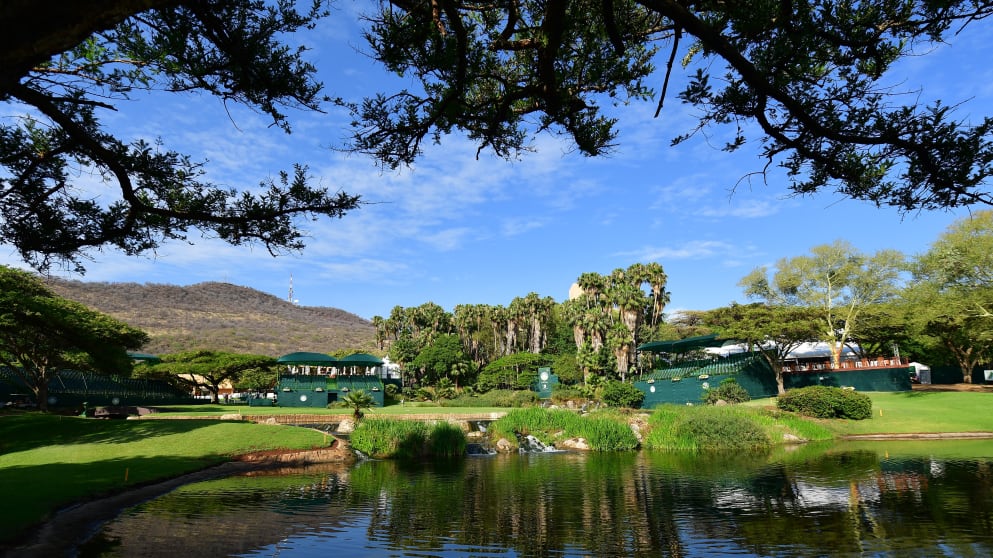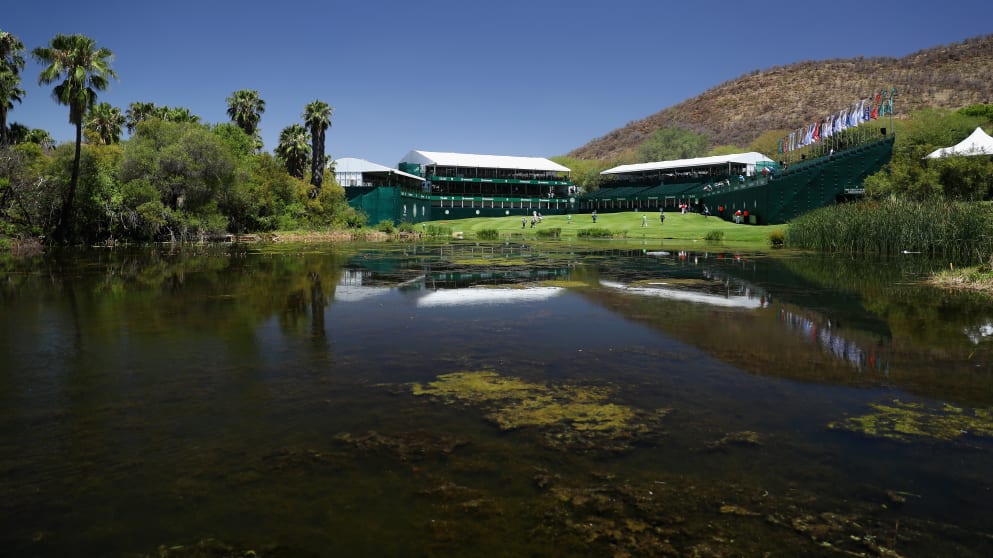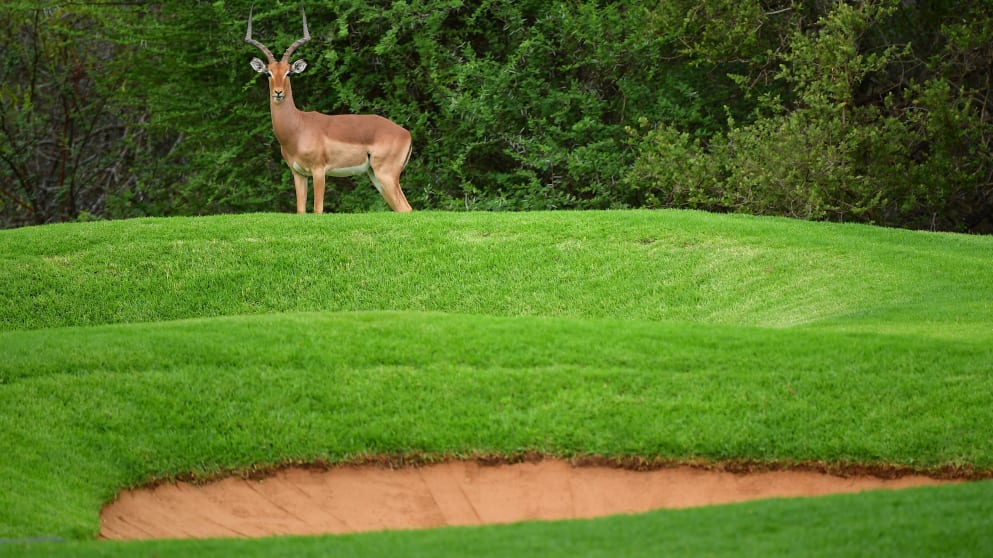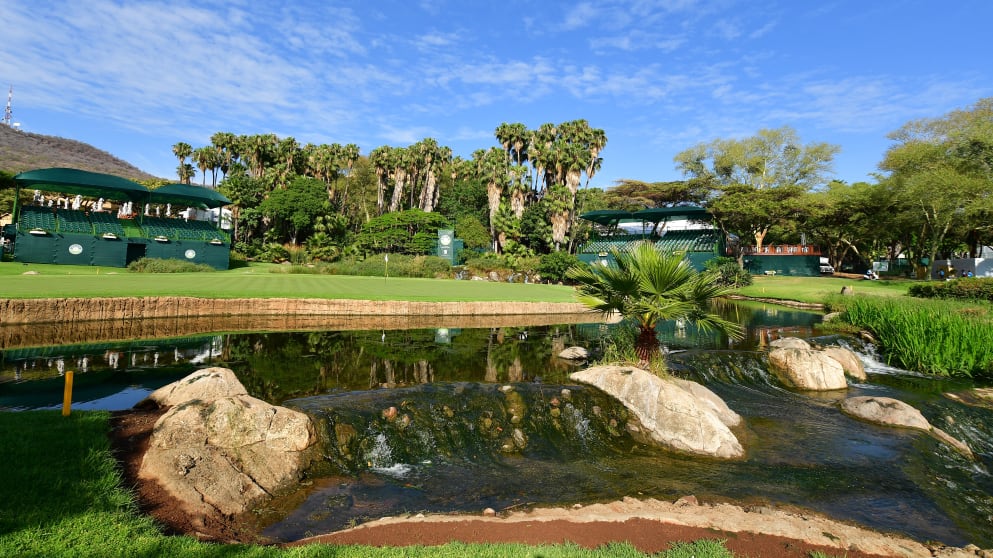Beautiful South Africa has long provided some of the European Tour's most breathtaking golf courses and this week is no exception as Gary Player Country Club takes centre stage for the seventh Rolex Series event of the season at the Nedbank Golf Challenge.

Career Grand Slam winner Player designed the course himself and it opened in 1979, hosting the first edition of this event in 1981 and every one since.
Designed in a volcanic crater and surrounded by Pilanesberg National Park, sightings of the big five - lions, Cape buffaloes, elephants, leopards and rhinos - are common along with a host of other wildlife.
The 18th tee has been moved since the 2017 edition and the rough is slightly down but this 7,817-yard gem will still provide a stern test with its narrow fairways and here, Player himself gives us the lowdown on all 18 holes.
HOLE ONE – 441 yards – Par four
"Most will hit a club from the tee that takes the fairway bunkers out of play. Players will be left with a mid-to-short-iron to a green that slopes sharply from back to front and with some potentially wicked pin placements. Distance control with the approach is vital to ensure a reasonably flat putt. It is important to hit the first fairway and it might be wise to take a three-wood."
HOLE TWO – 569 yards – Par five
"The first of four par fives, all of which are genuine scoring opportunities. A fairway bunker right in driver territory and a sharp left-to-right camber on the fairway make the tee shot tough, but everyone will take a chance with the driver here to create the chance of reaching the green in two. If you can’t reach in two, don’t take a driver off the tee."
HOLE THREE – 449 yards – Par four
"The tee shot on this par four is vital. A driver can leave a nine-iron or wedge into the green but the risks are high, with bunkers on the right of the fairway and bush on the left. The prudent play is a three-wood or less, which leaves a medium iron to a raised, well-bunkered and viciously sloping green. Most people are always short on their second shot. Remember the green slopes from left to right."

HOLE FOUR – 213 yards – Par three
"Playing over water to a small target, this hole demands a very accurate and considerate golf shot to find the green. The number of tee positions and depth of the green allow for a distinctly different shot requirement on all four days. Few are tempted by the traditional front-right pin position over the water on Sunday, while anywhere above the hole on this green leaves a lightning-fast putt. I recommend always playing for the back of the green."
HOLE FIVE – 491 yards – Par four
"Most will hit a three-wood off this tee to take a deep fairway bunker out of reach, which then leaves a medium-to-long iron into a green that was designed to accept short-iron shots. If the pin is in a corner of the green, then the prudent play is to aim for the middle of the green and be happy with a two-putt par."
HOLE SIX – 424 yards – Par four
"A short but potentially dangerous par four where the biggest threat lies in the tee shot, with a fairway bunker up the right and thick rough down the left. The green is well bunkered and is also protected by thick rough immediately in front of the green."

HOLE SEVEN – 211 yards – Par three
"The green has two distinct portions separated by a ridge, and to get the tee shot all the way to a back-left pin position requires a long iron even for the longer hitters. Although a front-right placement looks more inviting from the tee, it brings more bunkering on the right into play. I very seldom see anybody go past the pin on their tee shot. It is much more uphill than you think."
HOLE EIGHT – 492 yards – Par four
"A ditch running through the fairway rules the driver out off the tee, so almost everyone will be hitting a three wood here. Once the fairway has been found, there’s still plenty to do, with an approach that is uphill all the way to a green on which the pin can be tucked away. It’s frequently ranked the most difficult hole."
HOLE NINE – 596 yards – Par five
"The most popular spot for spectators, the ninth green and surrounding provide one of the great amphitheatres in South African sport. On at least two of the four days, the island green will be in range in two shots, setting up the possibility of two-putt birdies and the odd eagle, but some potentially big numbers as well. Always play for the middle of the green whether it is your second or third shot."

HOLE TEN – 547 yards – Par five
"A second consecutive par five that the players like to use to kick start their back nine charge. The green is comfortably the smallest target on the course, demanding absolute precision from more than 200 yards out if it is to be found in two, but you can expect to see a large number of up-and-down birdies here."
HOLE ELEVEN – 458 yards – Par four
"A visually intimidating tee shot, as the hole takes a 90-degree dog-leg from right to left and there is nothing but thick bush all the way up the left. The prudent play is to aim straight and be content with finding the fairway, even if it does mean a slightly longer approach. There is a lot more room on the right side so stay away from the left."
HOLE TWELVE – 219 yards – Par three
"It’s uphill all the way to the green on this short hole with a long, relatively narrow putting surface and some wicked slopes, especially near the back. The most important thing is to leave a putt from under the hole, as anything above will be difficult to stop."

HOLE THIRTEEN – 444 yards – Par four
"There’s a surreal feeling at this hole - being the furthest from the clubhouse, there are seldom many spectators. Four is always a good score as there is danger left and right off the tee, and a green full of slopes and subtleties. A back-right pin position is toughest, with a gaping bunker protecting the front. Straight uphill, so don’t be short and make sure you hit through the ball on your second shot."
HOLE FOURTEEN – 601 yards – Par five
"The infamous ‘love grass’ strategically scattered throughout the massive bunker that surrounds the green creates doubt in going for the green in two. Even for those laying up, the approach has to be absolutely precise with the green no more than ten paces deep in places. Considered a real birdie opportunity. The big thing is to stay out of the love grass in front of the green as it is really ‘hate’ grass if you go in."
HOLE FIFTEEN – 471 yards – Par four
"The real challenge lies in the tee shot. You need a miracle not to make bogey if you find the left-hand fairway bunker that is in range of a three wood off the tee. The bunker front right of the green is one of the deepest on the course, so to be shooting for a right-pin position, hitting the fairway off the tee is imperative. If you can draw the ball off the tee it is an advantage."
HOLE SIXTEEN – 211 yards - Par three
"This is one of my favourite par threes and when the flag is at the back the putt is always much slower. The pressure of the home stretch can cause the odd wayward tee shot on the otherwise least intimidating of the four par threes. The hole has the advantage of being versatile due to its variety of tee positions and the ridge running across the middle of the green to create two distinct tiers."
HOLE SEVENTEEN – 478 yards – Par four
"From the back tee, it is a carry of more than 200 yards just to reach the fairway. The real risk, however, is with the approach shot even with a good drive from the back tee, the players are left with a medium-iron shot to a green positioned in the famous Sun City lake, with a deep bunker to the right protecting against a bail-out. Don’t be embarrassed to play 17 for a bogey. The whole idea is to avoid a double bogey, don’t be greedy."
HOLE EIGHTEEN – 502 yards – Par four
"Most players will opt for a fairway wood or hybrid off the tee to ensure the best possible position in the fairway; the further left in the fairway, the better on this 90-degree dog-leg left. A pin position anywhere on the left is relatively accessible, but the traditional Sunday back right brings a gaping bunker into play and there is absolutely no margin for error with the approach. Take enough club for your second shot, everybody is usually short."







